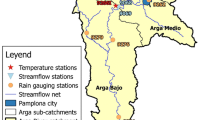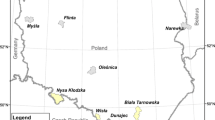Abstract
RHINEFLOW is a GIS based water balance model that has been developed to study the changes in the water balance compartments of the river Rhine basin on a monthly time basis. The model has been designed to study the sensitivity of the Rhine discharge to a climate change. The calculated discharge has been calibrated and validated on the period 1956 to 1980. For this period the model efficiency of RHINEFLOW is between 0.74 and 0.81 both for the entire Rhine and for its tributaries. Also calculated values for variations in other compartments, e.g. snow storage and actual evapotranspiration, were in good agreement with the measured values.
Since a high correlation between monthly discharge and peak discharge was found for the period 1900–1980 The RHINEFLOW model is used to assess the probability of exceedence for discharge peaks under possible future climate conditions.
The probabilities of exceedence were calculated from the conditional probabilities of peak discharges for a series of 15 classes of monthly discharges. Comparison of a calculated frequency distribution of high discharge peaks with observed peaks in a test series showed that the method performs well.
Scenarios for temperature changes between 0 °C and plus 4 °C and precipitation changes between plus 20% and minus 20% have been applied. Within this range flood frequencies are more sensitive for a precipitation change than for a temperature change. The present two-year return period peak flow (6500–7000 m3/s) decreases by about 6% due to a temperature rise of 4 °C; a precipitation decrease of 20% leads to 30% lower two-year peaks whilst 20% precipitation increase raises them by approximately 30%.
Application of a ‘Business As Usual’ (BAU) and an ‘Accelerated Policy’ (AP) climate scenario resulted in a significant increase in probability of peak flows for the BAU scenario, while for the AP scenario no significant change could be found. Due to sampling errors, accurate estimations of recurrence times of discharge peaks⩾7000 m3/s require a longer sampling time series than 90 years. For management purposes the method can be applied to estimate changes of probabilities of events with a relatively long recurrence time.
Similar content being viewed by others
References
CEC-DGE: 1992,Development of a Framework for the Evaluation of Policy Options to Deal with the Greenhouse Effect. A Scientific Description of the ESCAPE Model Version 1.1. Commission of European Communities, Directorate General for Environment, Nuclear Safety and Civil Protection.
Commissie Rivierdijken: 1977,Rapport Commissie Rivierdijken 1977,'s-Gravenhage. (in Dutch).
De Bruin, D., Hamhuis, D., Van Nieuwenhuyze, W., Overmars, W., Sijmons, D., and Vera, F.: 1987,Ooievaar, de Toekomst van het Rivierengebied, Gelderse Milieufederatie, Arnhem. (in Dutch).
IPCC: 1991,Climate Change: The IPCC Response Strategies, Island Press.
Kwadijk, J. C. J. and Rotmans, J.: 1993, ‘The Impact of Climate Change on the River Rhine: A Scenario Study’, in Kwadijk, J. C. J.,The Impact of Climate Change on the Discharge of the River Rhine, Netherlands Geographical Studies 171, Utrecht.
Nash, J. E. and Sutcliffe, J. V.: 1970, ‘River Flow Forecasting through Conceptual Models, Part 1-a Discussion of Principles’,J. Hydrol. 10, 282–290.
Parmet, B. W. A. H. and Mann, M. A. M.: 1991,Concept van een Hydrologisch Model for the Laagland Stroomgebied van de Rijn, Werkdocument 91.161×, Rijkswaterstaat. (in Dutch).
Rotmans, J.: 1990,IMAGE: An Integrated Model to Assess the Greenhouse Effect, Kluwer Acad. Publ.
Rotmans, J. and Hulme, M.: 1994, ‘Climate Change, Implications for Europe Based on Projections with the ESCAPE Model’, (submitted to Global Environmental Change).
Rotmans, J., De Boois, H., and Swart, R. J.: 1990, ‘IMAGE: An Integrated Model to Assess the Greenhouse Effect: The Dutch Approach’,Clim. Change 16, 331–356.
Rijkwaterstaat: 1988,Impact of Sea Level Rise on Society. Rapport Fase 1 van Onderzoek Delft Hydraulics. (in Dutch).
Rijkswaterstaat: 1992,Jaarboek van Afvoeren, Waterstanden, Golven en Waterkwaliteit 1990, DGW/RIZA,'s-Gravenhage. (in Dutch).
Snedecor, G. W. and Cochran, W. G.: 1989,Statistical Methods, Iowa State Univ. Press.
Ubels, J. W.: 1986,Verantwoording van het Hoogwateronderzoek op de Boven-Rijn, de Waal, het Pannerdensch Kanaal, de Neder-Rijn, de Lek en de IJssel, Nota nr. 86.035, Rijkswaterstaat, DBW/RIZA, Arnhem. (in Dutch).
Van Deursen, W. P. A. and Kwadijk, J. C. J.: 1990, ‘Using the Watershed Tools for Modelling the Rhine Catchment’, inProceedings on the First European Conference on G.I.S., pp. 254–263.
Warrick, R. A., Barrow, E. M. and Wigley, T. M. L.: 1990,The Greenhouse Effect and Its Implications for the European Community, Report EUR 12707 EN, Commission of the European Community.
Wigley, T. M. L. and Raper, S. C. B.: 1991,STUGE, an Interactive Greenhouse Model: Users Manual, Climate Research Unit, Norwich, 44 pp.
WL/RAND: 1993,Toetsing Uitgangspunten Rivierdijkversterkingen. Deelrapport 2: Maatgevende Belastingen, Department of Infrastructure Watermanagement, The Netherlands. (in Dutch).
Author information
Authors and Affiliations
Rights and permissions
About this article
Cite this article
Kwadijk, J., Middelkoop, H. Estimation of impact of climate change on the peak discharge probability of the river Rhine. Climatic Change 27, 199–224 (1994). https://doi.org/10.1007/BF01093591
Received:
Revised:
Issue Date:
DOI: https://doi.org/10.1007/BF01093591




